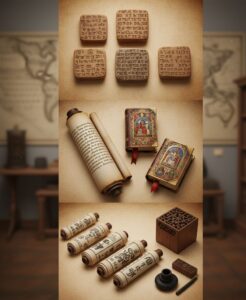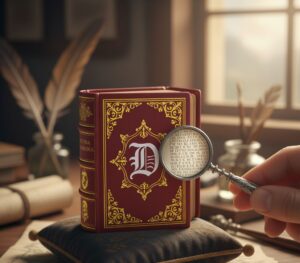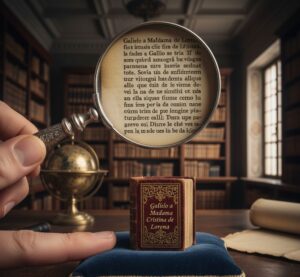Tiny Pages, Big History: Inside the World of Rare Miniature Books
For centuries, books have been the vessels of human knowledge and imagination. But imagine a library where the greatest classics, essential reference guides, and sacred texts could fit comfortably in the palm of your hand, a waistcoat pocket, or a lady’s purse. Welcome to the enchanting world of miniature books or mini books, tiny tomes that defy their size with their profound historical value and exquisite craftsmanship. These aren’t novelty toys—they’re real books, crafted with full text, bindings, printing, sometimes illustrations, but on a very small scale. In particular, antique miniature books—those produced in earlier centuries—represent a fascinating intersection of craftsmanship, portability, devotion, and artistry. Book lovers began collecting miniature books for their artistic appeal, historical significance, and treating them as antique treasures.
In this guide, we will explore the origin of miniature books, their distinctive features, the reasons they’re valuable, and some famous examples.

What are Miniature Books?

A miniature book, by modern consensus, is defined primarily by its dimensions. While standards have shifted over time, the accepted criterion, largely set by the Miniature Book Society in the United States, is that a miniature book must be no more than three inches (76 mm) in height, width, or thickness
The categories are often further broken down based on size:
- Macro-Miniature: Slightly larger books, typically between 3 and 4 inches.
- True Miniature: Books between 1 and 3 inches.
- Micro-Miniature: Books between 0.25 and 1 inch, often requiring a magnifying glass to read.
- Ultra-Micro-Miniature: Books less than 0.25 inches, sometimes requiring a high-powered microscope for reading.
What makes them “real” books, rather than simply tiny objects, is that they possess all the components of their full-sized counterparts: covers, spines, leaves (pages), printing, and often illustrations, all scaled down with remarkable precision.
Origin and History of Miniature Books

Early Origins
Miniature books trace back surprisingly far. Some of the earliest “booklike” objects in very small format were ancient clay tablets or early codices with small dimensions.
Most notably, miniature Sumerian clay tablets, Latin scrolls printed on vellum, and medieval books of hours
Darani Scrolls: In 770 CE, in an attempt to introduce Buddhism to Japan, Japanese Empress Shotoku commissioned scrolls of 2 1/4 inches to be printed using woodblock printing or bronze plate. These scrolls are known as the Hyakumanto Darani
The Printed Age & Popularisation
With the advent of the printing press in the 15th century and the spread of literacy, miniature books became more feasible.
16th-17th century:
The 16th and 17th centuries saw the production of hundreds of miniature books, primarily focusing on religious texts like Bibles, Psalms, and devotional works, as well as classical literature.
The record for the smallest book printed with movable type for over two centuries belonged to the Bloem-Hofje (Tiny Flower Garden), measuring just 12 x 8 mm (approx. 0.5 x 0.3 inches).
The Golden Age (19th Century)
The 19th century is widely considered the “Golden Age” of miniature books.
The burgeoning middle class and increased travel made miniature books highly functional. They were carried in waistcoat pockets, ladies’ handbags (reticules), or tucked into travelling trunks.
William Pickering’s Diamond Classics: The English publisher William Pickering significantly popularised the format with his series of Diamond Classics starting in 1819.
20th Century
By the 20th century, miniature books became collectible objects, some created for display (for instance, the famous miniature library inside Queen Mary’s Dolls’ House) and the format expanded into fine‐press and artist books.
https://www.youtube.com/watch?v=1Rrexehe8LM
Video Credit: Royal Collection Trust, rct.uk
Features of Antique Miniature Books
What sets antique miniature books apart is the incredible craftsmanship required to produce them at such a challenging scale.
- Size & Format
Typically, under 3 inches high (roughly 75 mm) is a common definition.
- Printing and Inking
To ensure legibility, printers often used specially cast, minute typefaces, such as “Diamond Type” or the notoriously small “Fly’s Eye Type.”
- Binding and Materials
Bindings are one of the most remarkable features. Antique miniatures were bound using the same high-quality materials as their larger counterparts, but with paper-thin leather and precise tooling:
Fine Leather: Often bound in full Moroccan leather, vellum, or elegant calfskin.
Gilt Work: Intricate gilt decoration and lettering were meticulously applied to the spine and covers.
Novelty Bindings: Some were housed in elaborate, purpose-built presentation boxes, slipcases, or featured unique bindings like silver or mother-of-pearl covers.
- Content and Design
Antique miniatures were far more than just reduced-size copies; they were often specially designed:
Illustrations: Many contained tiny, yet beautifully detailed, woodcuts, engravings, or hand-coloured illustrations.
Functionality: To maximise content, some featured fold-out pages (especially for maps or calendars) or accordion-style layouts.
Accessories: Some editions, particularly the ultra-microminiatures, were sold complete with their own tiny magnifying glass tucked into a pocket in the cover or presentation box.
Famous Antique Miniature Book Examples
The world of miniature books boasts many famous examples:
- The “Fly’s Eye” Dante (Divine Comedy 1878)

The 1878 edition of the Divine Comedy, printed by the Salmin Brothers of Padua, Italy, this edition measures only 11/4 by 13/4 inches; it is said to have taken 11 years to print, and to have damaged the eyes of both its compositor and corrector.
- Galileo’s Letter to Christina (1896)

Also printed by the Salmin Brothers, this Galileo a Madama Cristina de Lorena is even smaller, measuring just 0.7 x 0.4 inches, and is considered the smallest book ever printed with hand-set, movable type.
- David Bryce’s Miniatures (Late 19th Century)

The Scottish publisher David Bryce & Son produced a highly popular line of ultra-small books, often measuring less than an inch. His Smallest Bible in the World (1896) was a major commercial success.
- The Fruit of Philosophy (1832)
An early, controversial guide to birth control by Charles Knowlton. Its miniature format was deliberate, allowing it to be easily concealed and circulated, reflecting how the tiny size could be used for subversive or discreet purposes.
- A Book of Rhymes (by Charlotte Brontë)
A miniature book created by Brontë at age 13 (1829), measuring just 3.8 × 2.5 inches (about 9.7 × 6.4 cm). It sold for about £1 million in 2022, making it possibly the most expensive book by surface area.
Tiny Treasures, Monumental History
Antique miniature books are more than curiosities; they are a bridge connecting ancient human desires for portability with peak printmaking craftsmanship. They embody the principle of multum in parvo—much in little—packing intricate detail, high art, and deep historical context into a palm-sized package. For the collector, they offer a tangible link to the past and an opportunity to marvel at the technical brilliance of a bygone era. They remind us that true value in literature, just like in life, is often found in the most concentrated, carefully crafted, and intimate forms.






